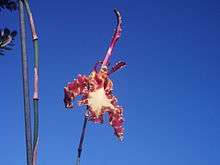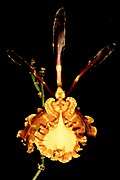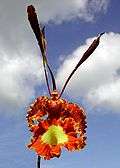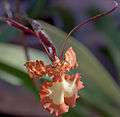Psychopsis
Psychopsis, abbreviated Psychp. in horticultural trade, is a genus of five known species of orchids native to northern South America, Central America and Trinidad.[1][2]
- For the genus of net-winged insects, see Psychopsis (insect).
| Butterfly orchid | |
|---|---|
 | |
| Psychopsis papilio | |
| Scientific classification | |
| Kingdom: | Plantae |
| Clade: | Tracheophytes |
| Clade: | Angiosperms |
| Clade: | Monocots |
| Order: | Asparagales |
| Family: | Orchidaceae |
| Subfamily: | Epidendroideae |
| Tribe: | Cymbidieae |
| Subtribe: | Oncidiinae |
| Genus: | Psychopsis Raf. |
| Synonyms[1] | |
| |

Description
Psychopsis are epiphytic orchids with laterally crushed cylindrical pseudobulbs from which two fleshy coriaceous leaves appear apically, in their center two floral wands emerge with large golden yellow flowers with purple spots on bands in sepals and on the lip whose edges are forming folds.
Psychopsis very often grows on the trunks and branches of trees. The flowers look like large butterflies with brightly colored bodies (the lip, a modified petal), very long antennae-like petals, and outspread wing-like dappled yellow and brown sepals.
The butterfly orchid is rumored to have started the European "Orchidmania" of the 19th century.
Taxonomy
It was formerly included in the massively paraphyletic "wastebin genus" Oncidium. Orchids in this genus are commonly called butterfly orchids, but some species of other orchid genera are also called thus.
Species
Species currently accepted as of June 2014:[1]
| Image | Name | Distribution | Elevation (m) |
|---|---|---|---|
 | Psychopsis krameriana (Rchb.f.) H.G.Jones | Costa Rica, Panama, Colombia, Ecuador, Suriname | 50 - 1300 |
| Psychopsis limminghei (E.Morren ex Lindl.) M.W.Chase | Brazil, Venezuela | ||
 | Psychopsis papilio (Lindl.) H.G.Jones | Panama, Trinidad, Colombia, Venezuela, Suriname, French Guiana, Brazil | 800 - 1200 |
| Psychopsis sanderae (Rolfe) Lückel & Braem | Peru, Brazil | 1220 | |
 | Psychopsis versteegiana (Pulle) Lückel & Braem | Suriname, Ecuador | 200 - 1200 |
References
- Kew World Checklist of Selected Plant Families
- Pridgeon, A.M., Cribb, P.J., Chase, M.C. & Rasmussen, F.N. (2009). Epidendroideae (Part two). Genera Orchidacearum 5: 1-585. Oxford University Press, New York, Oxford.
External links

